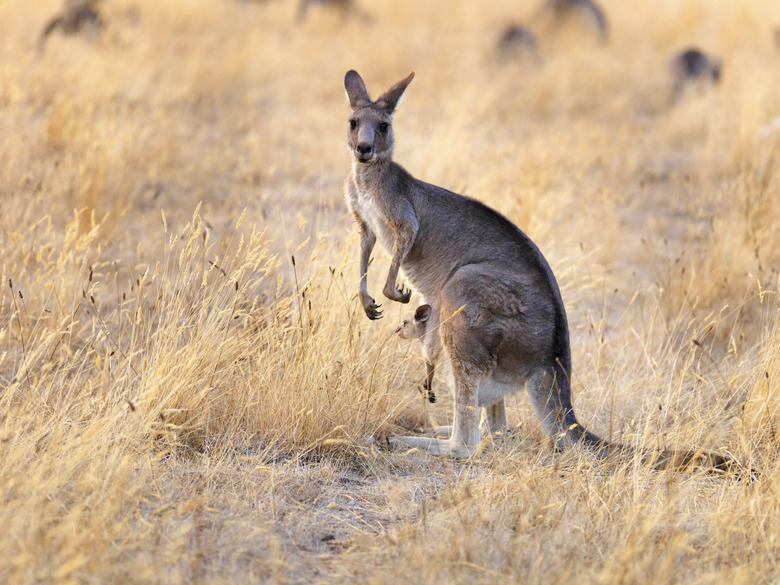List Of Marsupial Animals
Biologists categorize mammals as placental or marsupial. The embryos of placental animals grow inside a placenta connected to the blood supply in the mother and undergo a long period of gestation before birth. Marsupials are mammals that give birth to live babies much sooner, which make their way from the birth canal of their mothers to continue developing attached to a nipple inside a pouch. Marsupials bring to mind the iconic kangaroo mother, carrying her joey everywhere in a front pouch. The diversity of marsupial animals, however, is vast and fascinating.
TL;DR (Too Long; Didn't Read)
Marsupials are mammals with pouches instead of placentas for their babies' development. They dominate the mammals of Australia, but also have a substantial presence in North and South America. Numerous types of marsupials exist, whether two-legged or four-footed, herbivorous or carnivorous.
Characteristics of Marsupial Animals
Characteristics of Marsupial Animals
Marsupials reside only in the vicinity of Australia, North America and South America. Marsupials include both herbivores and carnivores. Marsupials represent the largest type of mammal in Australia. Marsupial characteristics vary widely among different species. They may be four-footed or two-legged. Marsupial skulls tend to possess a small brain but have a large face and jaws with rear portions that turn inward. Marsupial animals tend to have more teeth than placental animals, and they do not have two sets of teeth. The Virginia opossum boasts 52 teeth.
While many marsupials, such as the kangaroo, do possess the familiar, upward front pouch (marsupium), a number of species have a different setup of pouch or no pouch. Some pouches may be simple skin flaps around nipples. Some marsupial animals possess rear-opening pouches, particularly if they burrow. These pouches protect and warm the developing babies. Once the babies grow larger they can venture out of their pouches.
Marsupial females possess double reproductive parts. Two vaginas merge into one canal when it is time to give birth. Most marsupial animals are nocturnal, with the exception of the numbat (also called the banded anteater) in Australia. The largest marsupial is the male red kangaroo, and the smallest is the Pilbara ningaui.
Order Polyprotodonta Marsupial List
Order Polyprotodonta Marsupial List
In Order Polyprotodonta, the marsupial list can be categorized into three types of marsupial families: carnivorous, thylacine and bandicoot. Many bandicoot species reside in Australia. Carnivorous types of marsupials include dusky antechinus, eastern quoll, spotted-tail quoll, swamp antechinus, white-footed dunnart and the Tasmanian devil, the world's largest remaining carnivorous marsupial. The Tasmanian tiger or thylacine is now thought to be extinct.
Order Diprotodonta Marsupial List
Order Diprotodonta Marsupial List
Order Diprotodonta includes wombats, kangaroos, koalas and possums. Macropods include wallabies, kangaroos, potoroos and bettongs. Members of the possum marsupial list include the ringtail and sugar gliders, bushtail, cuscuses, and pygmy and feathertail gliders. The wombat is the largest herbivorous burrower mammal in the world.
Types of Marsupials in the Americas
Types of Marsupials in the Americas
American marsupials belong to either the Didelphidae (opossum) family or Caenolestidae family (shrew opossums). While many marsupial species once roamed North America, today only the Virginia opossum (Didelphis virginiana) remains. This scavenger animal lives throughout North America and favors moist forests. Several marsupial animals still exist in South America, especially in forests. These include the Monito del Monte of Chile, fat-tailed opossum, common/Virginia opossum, common mouse opossum and woolly opossum, among many others. The water opossum, or yapok, represents the only aquatic marsupial. It displays opposable thumbs and webbed feet, and its female's pouch seals tightly for water submersion.
Marsupial Origins in the Americas
Marsupial Origins in the Americas
Questions remain over the evolutionary and biogeographical history of animals in the marsupial list. Studies posit the arrival of marsupials to Australasia from the Americas. This single migration event presents considerable debate, for which ongoing research is needed.
Endangered Types of Marsupials
Endangered Types of Marsupials
A number of marsupial animals unfortunately classify as critically endangered. The endangered marsupial list includes the woylie, mountain pygmy possum, Christmas Island Shrew, Leadbeater's possum, northern hairy-nosed wombat and Gilbert's potoroo. Another threatened species is the greater bilby, which scientists hope to aid with reintroduction. Marsupials suffer from habitat degradation and human development. Learning more about marsupials aids in supporting their long-term survival.
References
- University of California Museum of Paleontology: Marsupial Mammals
- The Natural History Collections of the University of Edinburgh: Anatomical Differences Between Marsupial and Placental Mammals
- San Diego Zoo: Marsupial
- The Natural History Collections of the University of Edinburgh: American Marsupials
- Tasmanian Government Department of Primary Industries, Parks, Water and Environment: Carnivorous Marsupials and Bandicoots
- Tasmanian Government Department of Primary Industries, Parks, Water and Environment: Possums, Kangaroos and Wombats
Cite This Article
MLA
Hermance, Dianne. "List Of Marsupial Animals" sciencing.com, https://www.sciencing.com/list-marsupial-animals-8486997/. 30 July 2018.
APA
Hermance, Dianne. (2018, July 30). List Of Marsupial Animals. sciencing.com. Retrieved from https://www.sciencing.com/list-marsupial-animals-8486997/
Chicago
Hermance, Dianne. List Of Marsupial Animals last modified March 24, 2022. https://www.sciencing.com/list-marsupial-animals-8486997/
